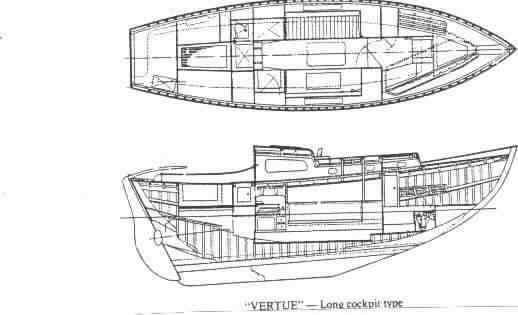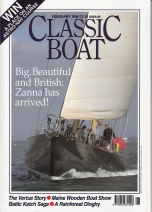The Vertue class yachts have been described as the finest cruising boats of their tonnage ever built. Yachting Monthly magazine recently rated the Vertue as 3rd out of the Top 100 Best Boats of the 20th Century. .
At least 180 Vertues have now been built all over the world, mostby either E.F. Elkins and Sons of Christchurch, Kent; Newman and Sons of Poole, Dorset or the Cheoy Lee Shipyard in Hong Kong (which is where Drumler was built). The GRP Vertue (ie. fibreglass) is licensed by only one builder: Bossoms Boatyard of Binsey Village, Oxford.
The first Vertue (though it was not yet called a Vertue – the class was not officially named until 1945) was the yacht Andrillot. Commissioned by Dick Kinnersley of Guernsey in 1936, he asked Jack Laurent Giles to design him a pocket cruiser with ‘a fine entry, turn on a sixpence, sailed single-handed, yet suitable for a couple and had enough sail aloft not to need an engine’.
Built by Moody’s boatyard in Southampton, Andrillot was a 25 foot 3 inch gaff-rigged cutter, of pine on oak, apparently designed as a modernized, miniature Bristol Channel Pilot Cutter. She had a very short, low coachroof, with sitting headroom and just two berths below. Her rig represented the highest development of the gaff cutter before it was finally replaced by the now more common Marconi Rig or Bermudan Sloop.
Andrillot soon earned herself a reputation as a very seaworthy boat, mainly due to the long passages she began to make, which were quite remarkable for a small yacht by the standards of the day. By the outbreak of the war, some ten sisters had been built, rigged as Bermudian sloops. One of these, Epeneta, skippered by Lawrence Biddle, won the Little Ships Club’s Vertue Cup in 1939 and it was from this cup that the class takes it name.
The post-war period brought with it many changes in values. Yachtsmen wanted better, smaller boats, and the Vertue was ideally suited to their needs. Giles made some alterations to improve the accommodations: a dog house was added to give standing headroom, the sheer was slightly straightened to create more sitting headroom over the berths, and the general layout was replanned. The original underwater lines have never been altered. Through all of her changes, her looks are a strange combination of delicacy and ruggedness.
Apocryphally, a sign on Durban‘s seafront forbids any yacht to put to sea in winds over Force 7, without the harbour master’s permission, unless she’s a Vertue.
There was a series of articles on the Vertue published by Classic Boat Magazine in 1996 (Feb, Mar & Apr issues), which give a lot more background history, and which you can download here.
And also a more recent article in Yachting World, in a series they ran in 2004 on ‘Modern Classics’. The November issue features the Vertue.




